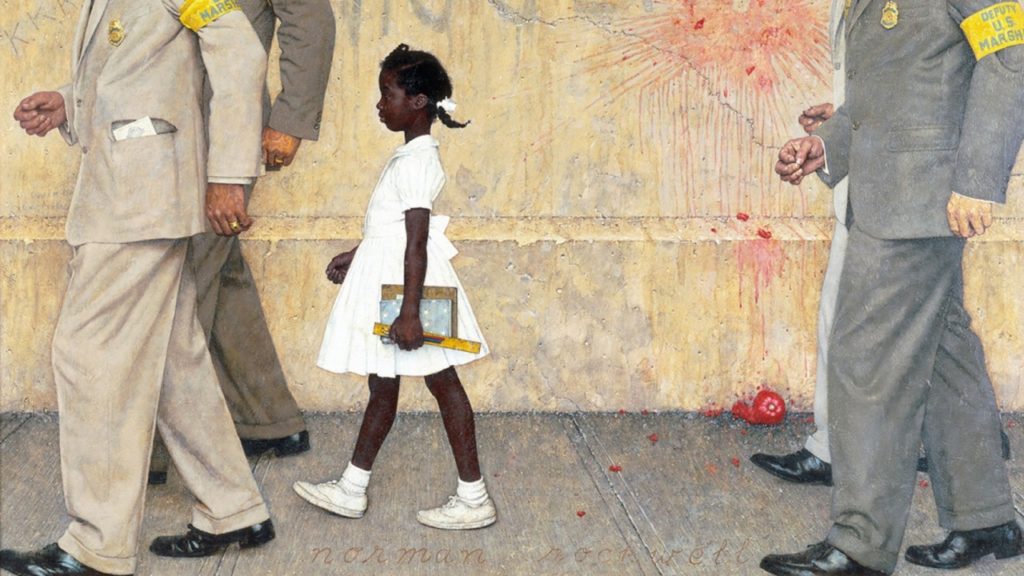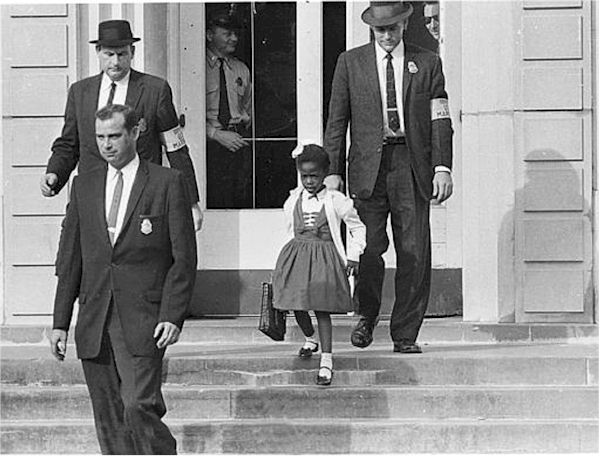Ten years before Louisiana Gov. John Bel Edwards was born, his grandfather, Frank Millard Edwards, Sr., voted in the Louisiana State Senate to enact several state laws that defied the Supreme Court’s 1954 Brown v. Board of Education school desegregation ruling.
Those laws helped prolong a bitter but unsuccessful four year legal fight by proponents of segregation that ended in the fall of 1960, but fueled the racial animosity captured in the iconic 1964 Norman Rockwell painting, “The Problem We All Live With,” which was inspired by a 1960 photograph of a young black girl, Ruby Bridges, walking to her newly integrated New Orleans public school accompanied by federal marshals.
Frank Millard Edwards, Sr. was in his first and only term as a State Senator representing Tangiapahoa County in 1956 when he joined his colleagues in unanimously passing what Louisiana State University Law School Professor Charles A. Raynard called “a thirteen-act package . . . calculated to maintain forced separation of the races in a variety of context” in a December 1956 article titled, “Survey of 1956 Louisiana Legislation: Legislation Affecting Segregation” published in The Louisiana Law Review:
Proponents of segregation obtained the adoption (without a dissenting vote) of a thirteen-act package of legislative measures at the Regular Session, calculated to maintain forced separation of the races in a variety of contexts. Seven of the new laws are aimed at the preservation of segregated public education.
Four of the others are concerned with public parks and recreational facilities, waiting rooms for passengers in intrastate commerce, employer-furnished sanitation, eating and drinking facilities for employees, and dances, social functions, entertainments, and athletic events. Two of the measures propose to amend the Constitution. The first designates various park and recreational bodies, and educational officers and boards to be agencies of the state, withdraws any previously granted consent to suits against them and forbids future suits against such agencies without the consent of the Legislature. The other constitutional proposal relates to voting registration and would change the procedure to be followed by an applicant who is denied the right to register when he seeks judicial relief.
These 13 pro-segregation laws unanimously passed by the Louisiana Legislature in 1956 were signed into law by Gov. Earl K. Long that same year.
One of the laws Frank Millard Edwards, Jr. voted for in 1956, Act 319, was a direct response to a February 15, 1956 decision in Bush v. Orleans Parish School Board by a panel of three federal judges, authored by Judge James Skelly Wright, which required the Orleans Parish School Board to comply with Brown v. Board of Education by desegregating the public schools in New Orleans.
“Act 319 provides for the classification of schools solely according to the race of the students, and would likely be held to be invalid on its face in light of the Brown decision, as interpreted and applied to Louisiana’s 1954 legislation in the Bush case,” Professor Raynard wrote:
Section 1 reads as follows:
“Those public schools in any city in Louisiana with a population in excess of Three Hundred Thousand (300,000) presently being utilized in the education of children of the white race through the twelfth grade of school shall from the effective date of this statute be utilized solely and exclusively in the education of children of the white race, unless otherwise classified by the Legislature as provided in [sections 3 and 4 hereof].”
“Since this statute directs that each school shall be used ‘solely and exclusively in the education of … children” of one race and thereby forbids the education of a child of the other race in that school, it is inescapable that it will operate to effect segregation – the very thing declared invalid by the Brown decision. The fact that the statute is drawn so as to be applicable only in the City of New Orleans (where the 1954 legislation was declared invalid) suggests that it is intended to avoid the effect of the Bush case,”
While Gov. Edwards is accountable only for his actions, and not those of his father, grandfather, or great-grandfather, he brought their past actions into the ongoing public debate surrounding the October 12 “jungle primary” in which he is seeking a second term when he touted his “family tradition” — and specifically the conduct of his father, grandfather, and great-grandfather–of “serving and protecting for generations” in a July ad.
Emboldened by the new laws unanimously passed by the Louisiana Legislature in 1956 and signed into law by Gov. Earl K. Long that same year, public school boards across the state, and particularly in New Orleans, continued to defy both the Supreme Court’s Brown v. Board of Education decision and Judge Wright’s decision in Bush v. Orleans Parish School Board. When the Supreme Court refused to hear its appeal in 1960, the Orleans Parish School Board reluctantly announced and began implementation of a plan to desegregate New Orleans public schools.
Supreme Court Justice Ruth Bader Ginsburg said of Judge Wright’s final order to the school board in a speech titled “Four Giants of Louisiana Law” delivered at the Loyola School of Law in New Orleans in 2002:
In May 1960, Judge Wright issued the first order ever in Fifth Circuit territory setting a day certain for the beginning of grade school desegregation. His signature on that order and earlier rulings, all of them stridently opposed by strong forces in this State and City, put his personal safety at risk. Opposition to the Judge’s day-certain order, his secretary recalled, had reached fever-pitch.
Wright’s order “incurred the wrath of uptown society, the business community, and the then powerful White Citizens’ Council of New Orleans,” The Tulanelink website recounts.
Writing at 64 Parishes, author Nikki Brown explained how the implementation of this 1960 decision by Judge Wright affected one little black girl, Ruby Bridges, whose walk to her local New Orleans public school accompanied by federal marshals that year would be captured in Norman Rockwell’s iconic 1964 painting, “The Problem We All Live With.”
In an attempt to postpone desegregation, the Orleans Parish School Board repeatedly asked Judge J. Skelly Wright for more time to implement the policy in June and July of 1960. When that failed, they asked Governor Jimmie Davis to intervene and then threatened to close all the public schools rather than desegregate them. Each time the school board resisted the order to desegregate, Judge Wright rejected the excuses and threatened to imprison any legislator attempting to thwart the law. Finally, the school board developed a plan to begin school integration utilizing a transfer arrangement. Each black student who wished to attend white schools was required to pass an intelligence test, which allegedly measured intellectual promise.
Brown noted:
The school board planned to integrate grade-by-grade, beginning with kindergarten and first grade. Four African American six-year-olds were selected to desegregate two elementary schools, both located in the white, working-class Ninth Ward. Ruby Bridges was assigned to William J. Frantz Elementary School, while Tate, Prevost, and Etienne were to attend McDonogh No. 19 Elementary School. The children were set to matriculate in September 1960 but the desegregation date was delayed until November 14 to give the schools additional time to prepare.
As soon as the girls entered their schools, a crisis erupted. Pro-segregation parents, encouraged by the Louisiana legislature and the Orleans Parish School Board, organized a boycott of the schools and bullied other parents into keeping their children home. “Cheerleaders,” as they called themselves, stood outside of McDonogh and Frantz and harassed parents sympathetic to integration. The cheerleaders screamed epithets, destroyed property, and splashed paint on the homes of sympathetic families. They even tried to get some parents fired.
During this crisis, Ruby Bridges became the focus of public attention. Every day she walked a gauntlet of vitriolic hatred. Outwardly, she appeared to handle the stress well. She remained attentive, good-natured, and stoic throughout the crisis. Her mother and father argued about continuing to send her to school, but eventually agreed that Bridges had become a role model for other children in the South.
On November 14 and for the rest of the school year, Bridges required the assistance of federal marshals who escorted her to and from school. A psychiatrist, Robert Coles, was also hired to counsel Bridges through the trauma. After one protestor threatened to poison her food, Bridges stopped eating the lunches her mother prepared for her. Her persistence was immortalized by Norman Rockwell in painting, “The Problem We All Live With.”
As white parents continued their boycott, Bridges was the only student in attendance at the school between January and May 1961. Tate, Preevost, and Etienne faced similar abandonment by white families at their elementary school. Despite the crisis, the process of desegregation continued the following school year. The courts told the Orleans Parish School Board in unequivocal terms that desegregation would continue. Legal challenges by the legislature and the school board continued to fail, and the federal government threatened to use force to uphold the law.
Gov. Edwards faces two Republican opponents, Rep. Ralph Abraham (R-LA) and businessman Eddie Rispone, in the October 12 “jungle primary.” If no candidates receives more than 50 percent of the vote, a runoff between the top two finishers will be held in November.
According to the most recent polls, Edwards is currently polling around 45 percent, and Abraham and Rispone are fighting for the second place spot in a potential runoff.
With less than a week to go before Louisiana voters go to the polls, it is unclear what impact Edwards’ “family tradition” misstep will have.



COMMENTS
Please let us know if you're having issues with commenting.